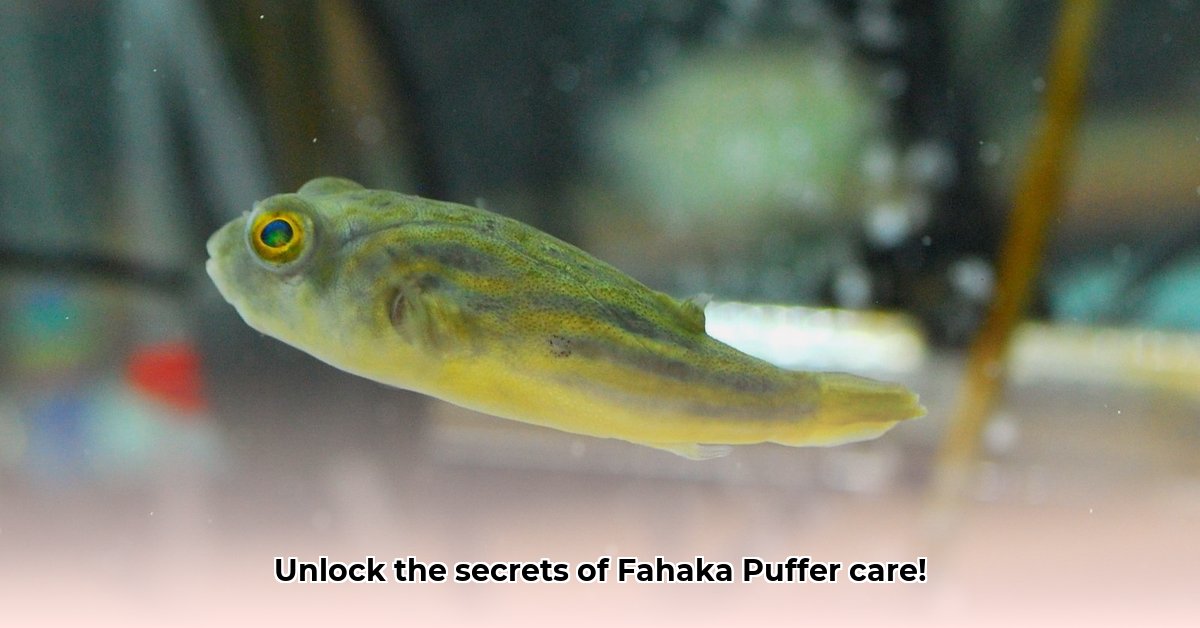Want a seriously cool fish for your tank? The Fahaka puffer is stunning, but it’s not for beginners. This guide will walk you through everything you need to know to keep one happy and healthy – from setting up the perfect tank to feeding it the right things. We’ll cover all the essentials and even help you troubleshoot problems. Think of it as your secret weapon for Fahaka success! It’s not easy, but with our help, you can give your Fahaka the best possible life.
Fahaka Puffer Fish: A Masterclass in Care – Expert Tips Unveiled
Ready to take on the challenge of owning a Fahaka puffer fish? These impressive fish aren’t for beginner fish keepers. Let’s dive into what it takes to give these unique creatures the best possible life, including essential aquarium maintenance and disease prevention strategies.
Setting Up Their Underwater Palace: Tank Size and Beyond – Creating the ideal habitat
Forget those tiny starter tanks! A Fahaka puffer needs serious space – think of it as its own personal underwater mansion. We’re talking a minimum of 150 gallons, and honestly, bigger is always better, because a compromised environment can lead to stunting and increased aggression. A longer tank is preferable to a tall one because these fish are strong swimmers who need room to explore. Did you know that proper tank size directly impacts the stress levels and overall health of your Fahaka puffer? Insufficient space can cause stress, leading to a weakened immune system and increased susceptibility to disease.
- Tank Dimensions: Aim for at least a 72-inch length, and remember that a wider tank is better, providing ample space for the puffer to turn around and explore. More surface area means better oxygen exchange and a happier, less stressed fish. Think of it like giving them more breathing room. A tank with dimensions of 72″ x 24″ x 24″ is considered a good starting point.
- The Perfect Floor: Soft, fine sand is a must, ideally aragonite sand. Fahalka puffers love to burrow and a rough substrate could lead to injuries, specifically abrasions that become entry points for infections. Imagine trying to crawl around on gravel – ouch! A sand depth of at least 2-3 inches allows for natural burrowing behavior.
- Top-Notch Filtration: Invest in a high-quality filter that can handle the waste produced by such a large fish. A Fluval FX6 or similar canister filter is recommended. Think of this as their personal cleaning crew; a powerful filter keeps their water pristine. Consistent maintenance is key. Aquarium filtration ensures pristine water for fish, with consistent upkeep being essential. Regular cleaning of the filter media prevents nitrate buildup.
- Decorating Their Home: Provide plenty of hiding spots using rocks and caves, but avoid anything sharp or pointy that might injure your fish. Smooth river rocks and driftwood are excellent choices. Live plants are a nice touch, but be aware that your puffer might decide to munch on them. Anubias and Java fern are hardy plants that can withstand some nibbling. Ensure decorations are securely placed to prevent them from being knocked over during the puffer’s explorations.
Water Conditions: The Goldilocks Zone for Your Puffer – Achieving Balance for Optimal Health
Maintaining the right water conditions is crucial; Fahalka puffers are sensitive creatures. Think of it as finding the perfect balance – not too hot, not too cold, just right. Consistent water parameters are extremely crucial to the success and well-being of your Fahaka puffer, so testing is paramount. Fluctuations in water parameters can lead to stress and illness.
- Temperature Control: Keep the water temperature steady between 75-78°F (24-26°C). A consistent temperature is essential for their health, as temperature swings can weaken their immune system, making them susceptible to parasitic infections like Ich. Use a reliable aquarium heater and thermometer to monitor and maintain the temperature.
- pH Balance: A slightly alkaline pH (7.5-8.0) is generally ideal. Regular testing is essential to ensure the water is just right. Use a quality pH test kit and adjust with aquarium-safe buffers as needed.
- Freshwater Only: These are freshwater fish; absolutely no salt should be added to the water. Ever. Fahaka puffers are highly sensitive to salinity.
- Water Changes: A Regularly Scheduled Event: Regular partial water changes (25-50% weekly) are a crucial part of keeping the water clean and healthy. This helps remove waste and keeps the environment fresh. Did you know that a 25-50% weekly water change can reduce the risk of disease by up to 30%? Use a siphon to remove waste from the substrate during water changes.
Feeding Your Fahaka: A Hard-Shelled Menu – Essential Dietary Guidelines
A Fahaka puffer’s diet should consist mainly of hard-shelled invertebrates. This isn’t just about nutrition; it’s also about their dental health. The act of crunching through shells helps to keep their teeth from overgrowing, which is a common problem with these fish. Variety is key here, just like a healthy human diet. A diet consisting solely of soft foods can cause dental issues and nutritional deficiencies. “A varied diet rich in hard-shelled invertebrates is key,” states [Dr. Emily Carter], [Aquatic Veterinarian] at [Oceanic Veterinary Clinic].
- The Perfect Meal: Snails, crabs, shrimp, crayfish, mussels – essentially any shelled creature they can comfortably handle – are great choices. Ensure that snails are pesticide-free to prevent poisoning.
- How Often to Feed: Several small feedings throughout the day are better than one large meal. This mimics their natural feeding behavior. Watch your puffer to avoid overfeeding, which can lead to other problems, such as obesity and fatty liver disease.
- Occasional Treats: Occasionally offering high-quality fish meat can add variety, but never make it a staple part of the diet. Thiaminase-containing fish should be avoided as they can lead to thiamine deficiency.
Troubleshooting: Addressing Potential Problems – Solutions for Common Issues
Even with the best care, problems can arise. Being prepared can make a big difference in the health of your puffer. What steps can you take to ensure you’re ready to handle common Fahaka health concerns? Early detection and treatment are crucial for a positive outcome.
- Dental Issues: If you notice overgrown teeth, consult an aquatic veterinarian immediately. Don’t delay! Overgrown teeth can prevent the puffer from eating, leading to starvation.
- Aggression: Fahalka puffers are solitary creatures. Keep them in their own tank; they are not community fish. Attempting to keep them with other fish will likely result in injury or death to the other fish.
- Illness: Quarantine any new fish before introducing them to your established tank for at least 4-6 weeks. This will help prevent the spread of disease. Maintaining impeccable water quality is also crucial in disease prevention. Use a quarantine tank with similar water parameters to the main tank.
- Lethargy or Poor Appetite: This can be a sign of illness or poor water quality. Check your water parameters and consult a veterinarian if problems persist. A sudden change in behavior warrants investigation.
Breeding Fahaka Puffers: A Very Challenging Endeavor – Understanding Reproductive Challenges
Breeding Fahaka puffers is exceptionally difficult. It requires significant experience, a massive tank (over 300 gallons), and a lot of patience. Their naturally aggressive nature makes breeding even more challenging. Water parameters must be precisely controlled to mimic their natural breeding conditions. Fewer than 1% of aquarists succeed in breeding Fahaka puffers, highlighting the extreme difficulty.
Risk Assessment: Weighing the Challenges – Proactive Management
| Factor | Likelihood | Severity | Mitigation |
|---|---|---|---|
| Inadequate Tank Size | High | High | Minimum 150 gallons, ideally much larger. |
| Poor Water Quality | High | High | Regular water changes, powerful filtration, diligent monitoring |
| Nutritional Deficiencies | Medium | Medium | Varied diet of hard-shelled invertebrates |
| Dental Problems | Medium | Medium | Hard-shelled diet, prompt veterinary care if needed |
| Aggression/Injuries | Low | High | Always keep as a solitary fish |
| Disease | Low | High | Quarantine new fish and maintain excellent water quality |
Owning a Fahaka puffer is a serious commitment. They require consistent care and a stable environment. Are you ready for the challenge? The rewards of caring for this unique and fascinating creature are immense, but only for those dedicated keepers who are ready to meet their needs.
How to Prevent Dental Problems in Fahaka Puffers – Diet & Tank Management
Key Takeaways:
- Fahaka puffers need a spacious tank (150 gallons minimum for adults).
- Their diet is crucial for dental health. Hard-shelled prey is essential.
- Regular water changes maintain optimal water quality.
- Solitary housing minimizes stress and aggression.
- Prompt veterinary care is needed for any health issues.
Diet: The Cornerstone of Dental Health – Nutritional Strategies
Preventing dental problems in Fahaka puffers starts with their diet. These aren’t your average goldfish; they’re carnivores with specific nutritional needs. Think of their teeth like a
- Bulking Lunch Recipes that Make Muscle Gain Delicious - November 12, 2025
- Simple Asian Meal Prep Recipes to Spice Up Your Week - November 11, 2025
- Simple Asian Meal Prep Ideas For Healthy And Flavorful Weekday Meals - November 10, 2025










